Feature #1706
Support composite spatial models
| Status: | Closed | Start date: | ||
|---|---|---|---|---|
| Priority: | Normal | Due date: | ||
| Assigned To: | - | % Done: | 100% | |
| Category: | - | |||
| Target version: | 1.2.0 | |||
| Duration: |
Description
I got an interesting feature request from Philipp Willmann.
He asked me if it is possible to fit one spectrum for a composite spatial model, e.g. a superposition of two Gaussians.
This might be a scenario that will come up more often towards CTA. Source morphologies are not always easy to model. Having a spatial model that is a superposition of individual models could help modelling complex morphologies.
We could have a new GModelSpatialComposite model that contains a std::vector<GModelSpatial> objects. I guess the only worry is to get the normalisation of the resulting PDF correct, right?
Of course we would also have to think about the XML interface. What first popped into my head are two options:
1. Have nested spatial models:
<spatialModel type="Composite>
<spatialModel type="GaussFunction">
...
</spatialModel>
<spatialModel type="GaussFunction">
...
</spatialModel>
</spatialModel>
2. Allow several spatial, spectral (and temporal) models per GModelSky element:
<spatialModel type="GaussFunction"> ... </spatialModel> <spatialModel type="GaussFunction"> ... </spatialModel>
This could, in principle also allow several spectral components for one spatial model. An important use case for this is e.g. the Crab in Fermi where we have a pulsed spectrum, the synchrotron and IC component from one single spot in the sky.
I haven’t thought about how this could be done technically yet, I just wanted to mention it here that we don’t forget about it.
Recurrence
No recurrence.
History
#1
 Updated by Knödlseder Jürgen almost 9 years ago
Updated by Knödlseder Jürgen almost 9 years ago
I think we can solve this issue by introducing the concept of connected or linked parameters (or maybe joint parameters).
The idea I had in mind to add something like the following to the model definition XML file:
<?xml version="1.0" standalone="no"?>
<source_library title="source library">
<source name="Crab pulsar" type="PointSource">
<spectrum type="PowerLaw">
<parameter name="Prefactor" scale="1e-16" value="5.7" min="1e-07" max="1000.0" free="1"/>
<parameter name="Index" scale="-1" value="2.48" min="0.0" max="+5.0" free="1"/>
<parameter name="Scale" scale="1e6" value="0.3" min="0.01" max="1000.0" free="0"/>
</spectrum>
<spatialModel type="SkyDirFunction">
<parameter max="360" min="-360" name="RA" scale="1" value="83.6331" free="1" />
<parameter max="90" min="-90" name="DEC" scale="1" value="22.0145" free="1" />
</spatialModel>
</source>
<source name="Crab nebula" type="PointSource">
<spectrum type="PowerLaw">
<parameter name="Prefactor" scale="1e-16" value="5.7" min="1e-07" max="1000.0" free="1"/>
<parameter name="Index" scale="-1" value="2.48" min="0.0" max="+5.0" free="1"/>
<parameter name="Scale" scale="1e6" value="0.3" min="0.01" max="1000.0" free="0"/>
</spectrum>
<spatialModel type="SkyDirFunction">
<parameter max="360" min="-360" name="RA" scale="1" value="83.6331" free="1" />
<parameter max="90" min="-90" name="DEC" scale="1" value="22.0145" free="1" />
</spatialModel>
</source>
<link>
<source name="Crab pulsar" parameter="RA">
<source name="Crab nebula" parameter="RA">
<parameter max="360" min="-360" name="RA" scale="1" value="83.6331" free="1" />
</link>
</source_library>
The
<link> information should be saved together with the parameters in a GModels container. The methodvoid GObservations::optimize(GOptimizer& opt)
{
// Extract optimizer parameter container from model container
GOptimizerPars pars = m_models.pars();
// Optimize model parameters
opt.optimize(m_fct, pars);
// Return
return;
}
should scan the linked parameters and make modifications to the parameters. All linked parameters should be fixed, and an additional parameter should be added that reflects the common linked parameter. We then have to think how to resolve the parameters in the model evaluation.
#2
 Updated by Knödlseder Jürgen over 8 years ago
Updated by Knödlseder Jürgen over 8 years ago
We discussed this issue today during the coding sprint and the following format seems to be most easy to implement:
<?xml version="1.0" standalone="no"?>
<source_library title="source library">
<source name="Crab" type="PointSource">
<spatialModel type="Composite">
<spatialModel type="PointSource">
<parameter name="RA" scale="1.0" value="83.6331" min="-360" max="360" free="1"/>
<parameter name="DEC" scale="1.0" value="22.0145" min="-90" max="90" free="1"/>
</spatialModel>
<spatialModel type="RadialGaussian">
<parameter name="RA" scale="1.0" value="83.6331" min="-360" max="360" free="1"/>
<parameter name="DEC" scale="1.0" value="22.0145" min="-90" max="90" free="1"/>
<parameter name="Sigma" scale="1.0" value="0.20" min="0.01" max="10" free="1"/>
</spatialModel>
</spatialModel>
<spectrum type="PowerLaw">
<parameter name="Prefactor" scale="1e-16" value="5.7" min="1e-07" max="1000.0" free="1"/>
<parameter name="Index" scale="-1" value="2.48" min="0.0" max="+5.0" free="1"/>
<parameter name="PivotEnergy" scale="1e6" value="0.3" min="0.01" max="1000.0" free="0"/>
</spectrum>
</source>
</source_library>
<?xml version="1.0" standalone="no"?>
<source_library title="source library">
<source name="Crab" type="PointSource">
<spatialModel type="PointSource">
<parameter name="RA" scale="1.0" value="83.6331" min="-360" max="360" free="1"/>
<parameter name="DEC" scale="1.0" value="22.0145" min="-90" max="90" free="1"/>
</spatialModel>
<spectrum type="Composite">
<spectrum type="PowerLaw">
<parameter name="Prefactor" scale="1e-16" value="5.7" min="1e-07" max="1000.0" free="1"/>
<parameter name="Index" scale="-1" value="2.48" min="0.0" max="+5.0" free="1"/>
<parameter name="PivotEnergy" scale="1e6" value="0.3" min="0.01" max="1000.0" free="0"/>
</spectrum>
<spectrum type="Gaussian">
<parameter name="Normalization" scale="1e-10" value="1.0" min="1e-07" max="1000.0" free="1"/>
<parameter name="Mean" scale="1e6" value="5.0" min="0.01" max="100.0" free="1"/>
<parameter name="Sigma" scale="1e6" value="1.0" min="0.01" max="100.0" free="1"/>
</spectrum>
</spectrum>
</source>
</source_library>
GModelSpatialComposite class, the spectral composite model by the GModelSpectralComposite class. Both classes would be container classes for spatial or spectral model components, and would simply loop over its components in the eval(), flux() and eflux() methods.
In the examples above there are two components shown, but the composite model may eventually contain an arbitrary number of components.
Note that there may be an issue with accessing model parameters by name of a composite model since the parameter names within a model component (for example a spectral model component) need to be unique. This could be solved for example by prepending a component index internally, e.g. “RA” could become “1:RA” for the first component.
The implementation of the mc() method needs also some thinking. The composite classes probably need to randomly dispatch between the model components, and then call the mc() method of the component.
#3
 Updated by Mayer Michael over 8 years ago
Updated by Mayer Michael over 8 years ago
- File HardComponent_Index.png added
- File HardComponent_Prefactor.png added
- File SoftComponent_Index.png added
- File SoftComponent_Prefactor.png added
- Status changed from New to In Progress
- Target version set to 1.2.0
- % Done changed from 0 to 50
I have implemented the new class GModelSpectralComposite including unit tests and example XML files.
The pull distributions also look reasonable. The distributions below were made using two power law components, one with an index of -3.5 and the other using an index of -2.0. More pull distributions are underway.
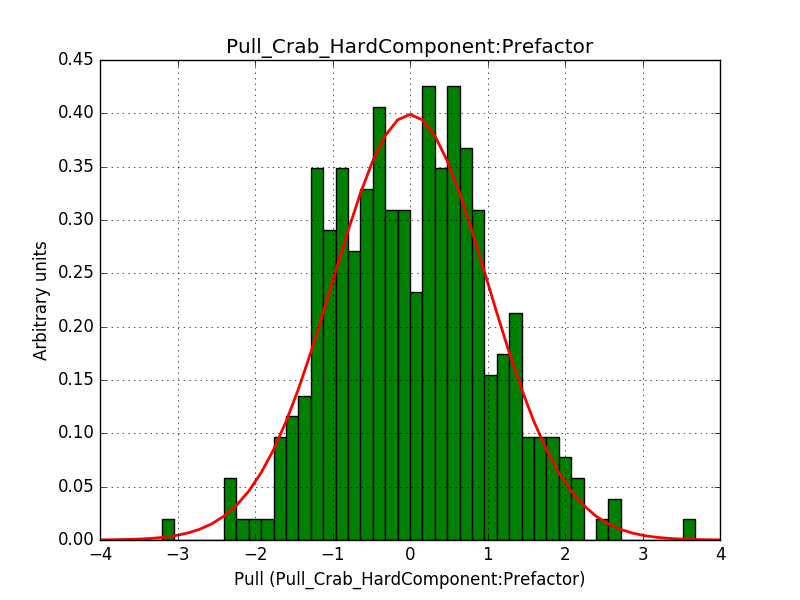
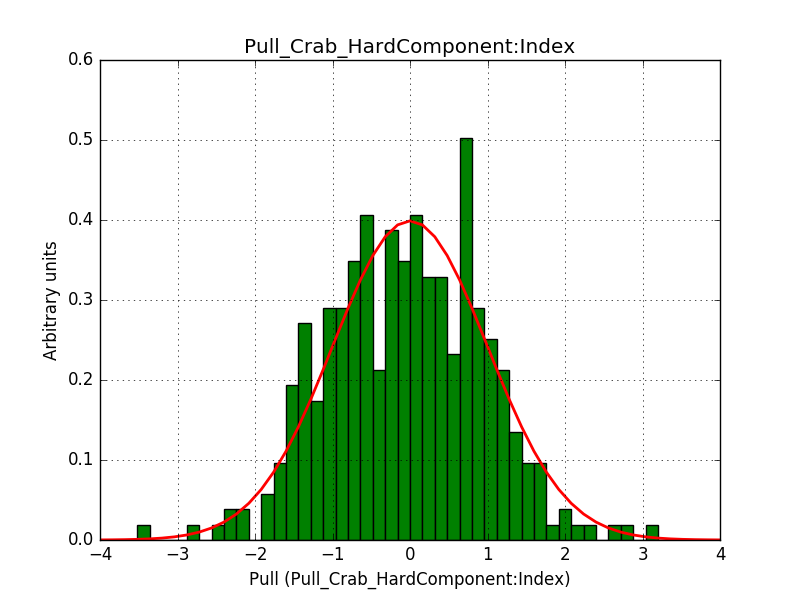
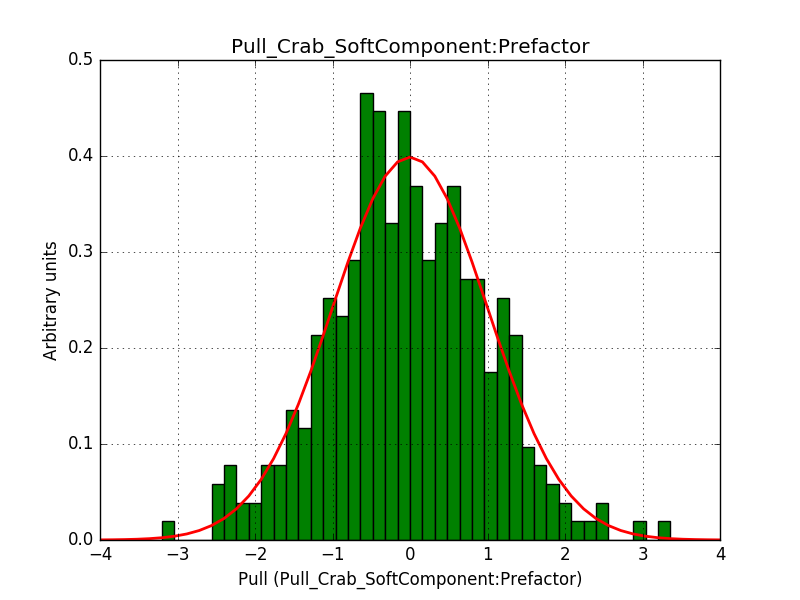
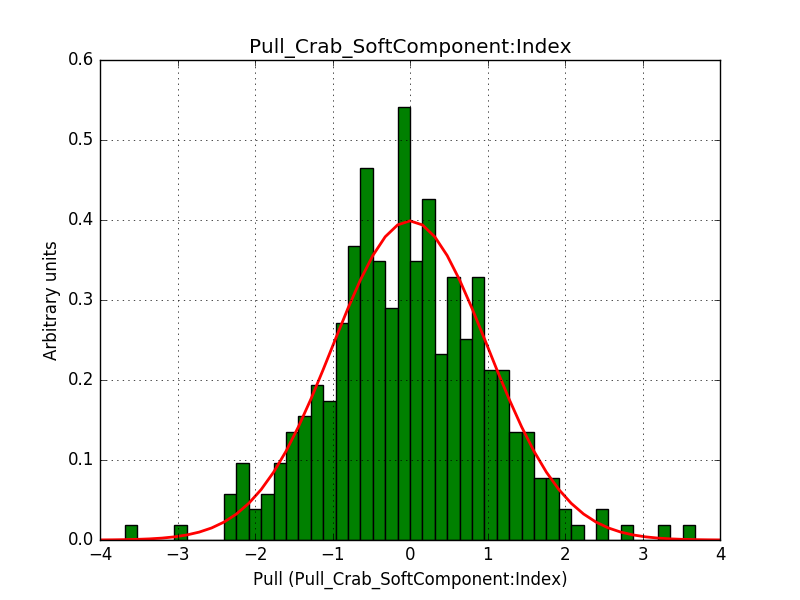
#4
 Updated by Mayer Michael over 8 years ago
Updated by Mayer Michael over 8 years ago
- % Done changed from 50 to 60
I have added a new function to GTools that we can use consistently:
bool gammalib::contains(std::vector<std::string> strings, std::string string);
This will check if a string is contained in a vector of strings. I omitted adding a python interface for this function since this call in python is simply:
contained = string in strings
#5
 Updated by Mayer Michael over 8 years ago
Updated by Mayer Michael over 8 years ago
Added related feature #1865 to not forget about documentation 
#6
 Updated by Tiziani Domenico over 8 years ago
Updated by Tiziani Domenico over 8 years ago
I have implemented the new GModelSpatialComposite class with corresponding unit tests.
The pull distributions that I obtained for a composite model of two point sources with a distance of one degree between them look quite reasonable.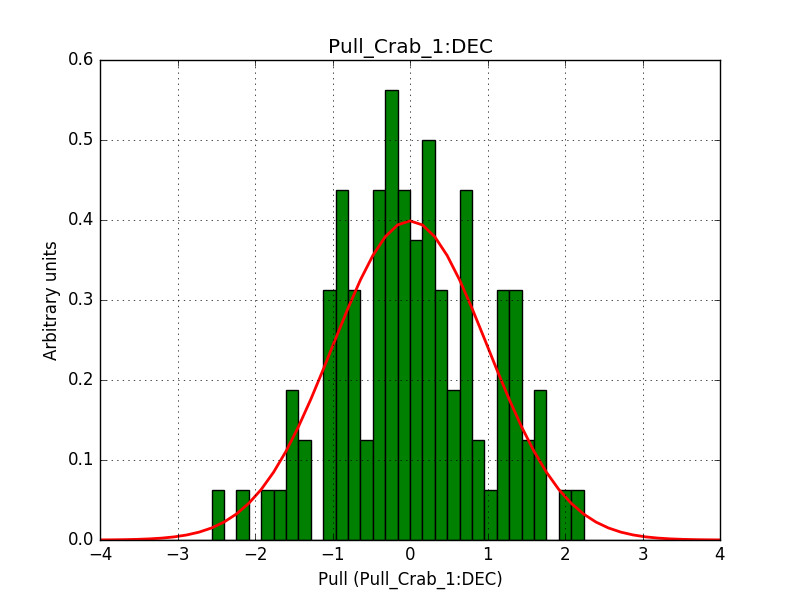
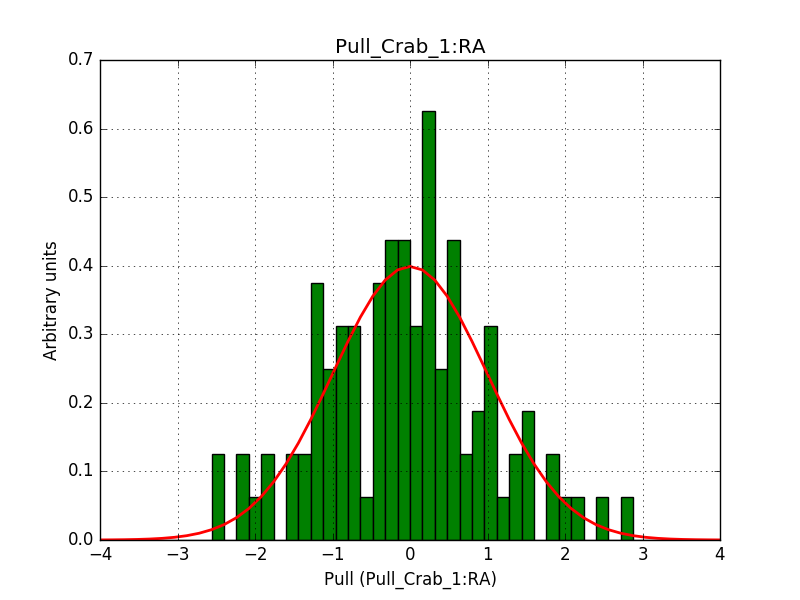
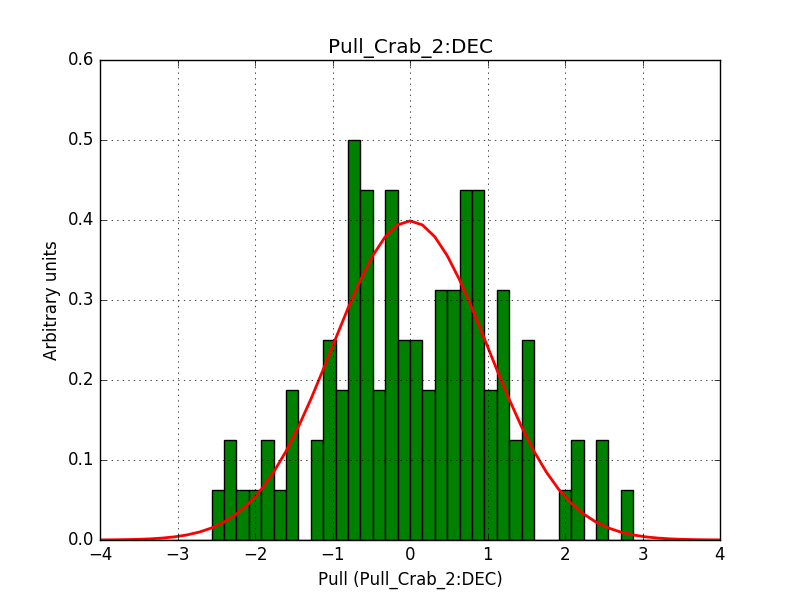
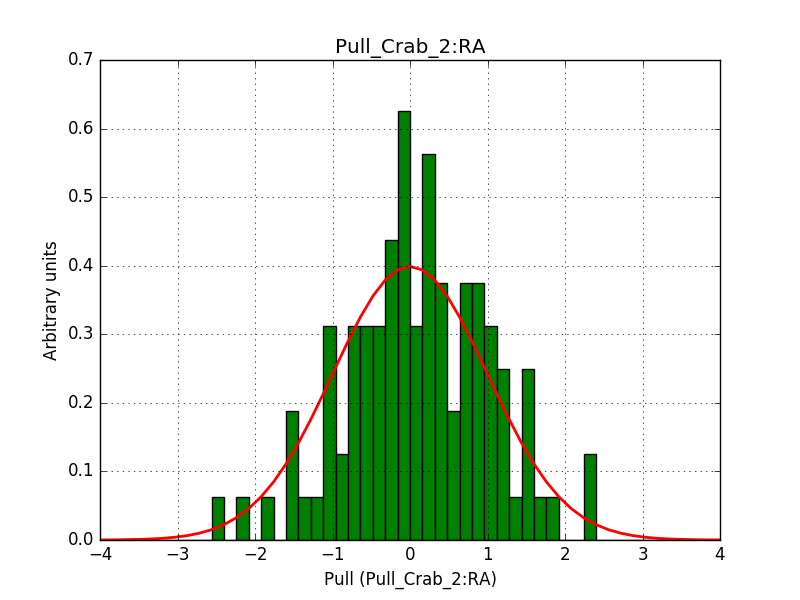
#7
 Updated by Tiziani Domenico over 8 years ago
Updated by Tiziani Domenico over 8 years ago
- Status changed from In Progress to Pull request
The features of this issue are implemented in the branch 1706-composite-models in Michael’s repository:
https://cta-gitlab.irap.omp.eu/mmayer/gammalib.git
#8
 Updated by Mayer Michael over 8 years ago
Updated by Mayer Michael over 8 years ago
Thanks Domenico.
@jknoedlseder: I wanted to make some comments to the code on gitlab but apparently I can only comment on the snippets that were changed during latest commit. Is there the option to add comment on an entire file?
#9
 Updated by Mayer Michael over 8 years ago
Updated by Mayer Michael over 8 years ago
- % Done changed from 60 to 90
#10
 Updated by Knödlseder Jürgen over 8 years ago
Updated by Knödlseder Jürgen over 8 years ago
Mayer Michael wrote:
Thanks Domenico.
@jknoedlseder: I wanted to make some comments to the code on gitlab but apparently I can only comment on the snippets that were changed during latest commit. Is there the option to add comment on an entire file?
I think you can only comment commits, but not files.
#11
 Updated by Knödlseder Jürgen over 8 years ago
Updated by Knödlseder Jürgen over 8 years ago
- Status changed from Pull request to Feedback
- % Done changed from 90 to 100
Thanks for the code. These new models are really great. Looking forward to use them 
Also congrats Domenico, these are your first commits to GammaLib 
I integrated the code into the devel branch.
It would be good if you could double check with pull distributions that everything is okay. Once you confirm I will close the issue.
#12
 Updated by Mayer Michael over 8 years ago
Updated by Mayer Michael over 8 years ago
We could still think of adding a “weight” attribute to each component of the GModelSpatialComposite to be read from the XML file. This way, we could have spatial components with different amplitudes as a combined spatial model.
This could also be an add-on as a separate feature, what do you think?
#13
 Updated by Knödlseder Jürgen over 8 years ago
Updated by Knödlseder Jürgen over 8 years ago
Mayer Michael wrote:
We could still think of adding a “weight” attribute to each component of the
GModelSpatialCompositeto be read from the XML file. This way, we could have spatial components with different amplitudes as a combined spatial model.
This could also be an add-on as a separate feature, what do you think?
I support this idea. Maybe make it a separate feature.
#14
 Updated by Tiziani Domenico over 8 years ago
Updated by Tiziani Domenico over 8 years ago
Mayer Michael wrote:
We could still think of adding a “weight” attribute to each component of the
GModelSpatialCompositeto be read from the XML file. This way, we could have spatial components with different amplitudes as a combined spatial model.
This could also be an add-on as a separate feature, what do you think?
I also agree. I think that I can implement this since I already created the class GModelSpatialComposite.
#15
 Updated by Mayer Michael over 8 years ago
Updated by Mayer Michael over 8 years ago
Great, thanks Domenico. You can just go ahead, create the issue and make a new branch from devel to implement the changes.
#16
 Updated by Tiziani Domenico over 8 years ago
Updated by Tiziani Domenico over 8 years ago
Added feature #1872 for the weight attribute.
#17
 Updated by Tiziani Domenico over 8 years ago
Updated by Tiziani Domenico over 8 years ago
I just re-calculated pull distributions for a spatial composite model and they still look OK.
#18
 Updated by Knödlseder Jürgen over 8 years ago
Updated by Knödlseder Jürgen over 8 years ago
Tiziani Domenico wrote:
I just re-calculated pull distributions for a spatial composite model and they still look OK.
Thanks for double checking.
#19
 Updated by Mayer Michael over 8 years ago
Updated by Mayer Michael over 8 years ago
Tiziani Domenico wrote:
Added feature #1872 for the weight attribute.
This link goes somewhere else.
#20
 Updated by Knödlseder Jürgen over 8 years ago
Updated by Knödlseder Jürgen over 8 years ago
Mayer Michael wrote:
Tiziani Domenico wrote:
Added feature #1872 for the weight attribute.
This link goes somewhere else.
Just remove the Redmine thing, #1872.
#21
 Updated by Knödlseder Jürgen almost 8 years ago
Updated by Knödlseder Jürgen almost 8 years ago
- Status changed from Feedback to Closed







